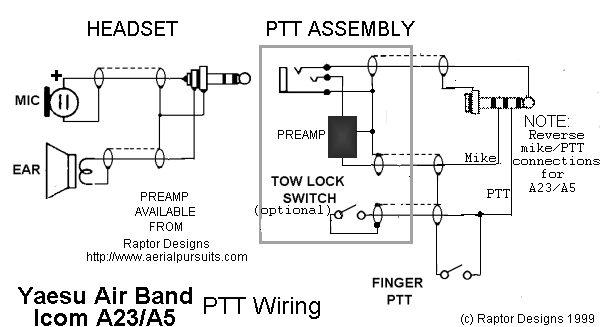
Air Band Radios - Airband radios are useful if you are flying
from or near an airport. There are a number of small hand-held air
band radios available now, such as ICOM's Handheld Airband model. Be warned
however, that standard Ham radio type microphones will not work with the
air band radios. It took me several months of frustration to finally
learn the solution to this. Aerial Pursuits (Australia) was able
to describe the problem as being one of a different
standard that is based on old carbon microphones. All that is
needed is to fix the problem is a small pre-amplifier which they also sold.
Note: some of the newer handheld Airband radios have Bluetooth capability, which may be a way
to bypass the different wiring standards.
Unfortunately, www.aerialpursuits.com no longer has a web presence (2022), and the domain may be for sale. I used the Web Archive (Wayback Machine) to recover the information, and have placed it below. As they are no longer available to sell the preamplifier, you will have to be creative to adapt one of your own.
Air band radios are AM band, which means they don't have the normal noise suppression of FM (ham radio) bands. That is, the unshielded Radne ignition is very audible. You will need either resistor spark plugs or resistor wire if you wish to use the radio while the engine is running.
The information below was recovered from the Web Archive for http://www.aerialpursuits.com/comms/mikes.htm, which is no longer available.
Air band headsets and intercoms are based around 1930's telephone set standards.
If you have an older telephone (pretty much any
phone with a rotary dial ), then it probably uses a carbon
microphone.  Carbon mikes have been around a long time and they were used in telephones
because they put out a very large signal, though they're decidedly
low-fi. The earliest telephone circuits included basically a
battery, two carbon mikes and two earpiece speakers, all connected in
series. The carbon microphone generated enough signal that even without an
amplifier it could drive the earpiece. A carbon mike consists of a
diaphragm that compresses a small canister full of carbon granules. When
compressed, the resistance is less, and vice-versa.
Carbon mikes have been around a long time and they were used in telephones
because they put out a very large signal, though they're decidedly
low-fi. The earliest telephone circuits included basically a
battery, two carbon mikes and two earpiece speakers, all connected in
series. The carbon microphone generated enough signal that even without an
amplifier it could drive the earpiece. A carbon mike consists of a
diaphragm that compresses a small canister full of carbon granules. When
compressed, the resistance is less, and vice-versa.
This was the sort of mike they used in early aircraft, because they were sturdy and reliable, along with fairly high impedance telephone-type earpieces. They also had available the sorts of plugs and jacks available in telephone exchanges. This set a standard that has not changed in the last 60 years. Our aviation headsets still use telephone switchboard plugs, and the microphones and speakers are still required to have the same characteristics as the old carbon microphones!
But, I hear you say... "We use electret (or dynamic) microphones in our headsets!!"
Of course, you are right, but if you were to take
apart the electret microphone element at the end of your headset boom, you
would discover that as well as an electret microphone, there is a small
circuit board with a 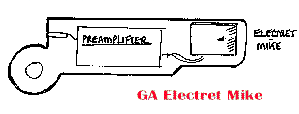 handful of components. This board is a preamplifier, and
it's required to boost the signal available from the electret microphone
to the same level as you would expect from a carbon microphone. It
adds nothing, in general, to the fidelity of the signal (Actually it
distorts it slightly). It's only there to maintain the standard!
handful of components. This board is a preamplifier, and
it's required to boost the signal available from the electret microphone
to the same level as you would expect from a carbon microphone. It
adds nothing, in general, to the fidelity of the signal (Actually it
distorts it slightly). It's only there to maintain the standard!
This is the reason that GA microphones cost so much compared with a simple electret microphone element. Of course, the electret capsule used in aircraft is generally a noise-cancelling or directional type, and this adds slightly to the cost as well.
Air band radios and intercoms are of course designed to the GA standard, and require the microphones to look electrically like a carbon mike, and for the earpieces to have a high (about 150-300 ohms) impedance as well. They present about 9 volts at the microphone terminal to drive the preamp and mike.
Of course, no such standard exists for
non-GA equipment, so most manufacturers use the simplest system
they can - generally a bare electret or dynamic mike (no preamp) and
commonly available 8 ohm earpieces, for UHF-CB or 2m FM radios.
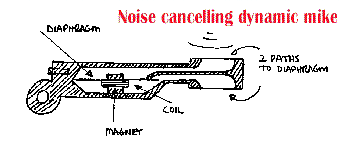 They also use a huge variety of different schemes for transceiver
activation. Most of them expect any connected electret mike to have
about a 2.2k impedance and present about 5V to drive it. If you
connect a GA mike to these transceivers, depending on the type of pre-amp
in it, it will either not work at all because insufficient voltage is
available, or overmodulate the transmit signal because the output is way
too high. If you try to use a bare electret mike element in a
GA application, it will generally undermodulate due to lack of signal.
They also use a huge variety of different schemes for transceiver
activation. Most of them expect any connected electret mike to have
about a 2.2k impedance and present about 5V to drive it. If you
connect a GA mike to these transceivers, depending on the type of pre-amp
in it, it will either not work at all because insufficient voltage is
available, or overmodulate the transmit signal because the output is way
too high. If you try to use a bare electret mike element in a
GA application, it will generally undermodulate due to lack of signal.
If your headset uses a "dynamic" microphone, a preamplifier is also required for GA operation and will be found in the earcup.
The information below was recovered from the Web Archive for http://www.aerialpursuits.com/comms/pttccts.htm, which is no longer available.
© 1996-2007 Raptor Designs Pty Ltd. (Last Update 27th September 2007)
Please contact us here at Raptor Designs if you wish to purchase a Heaset/PTT Kit suitable for construction of a finger switch PTT.. . This includes:
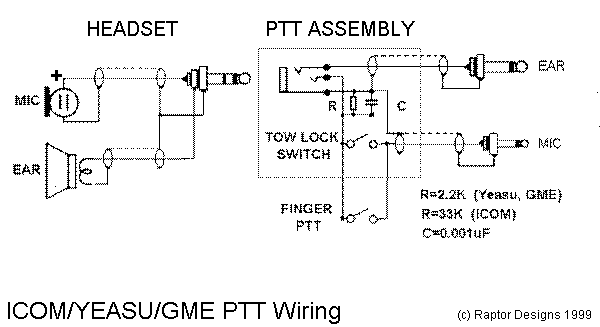
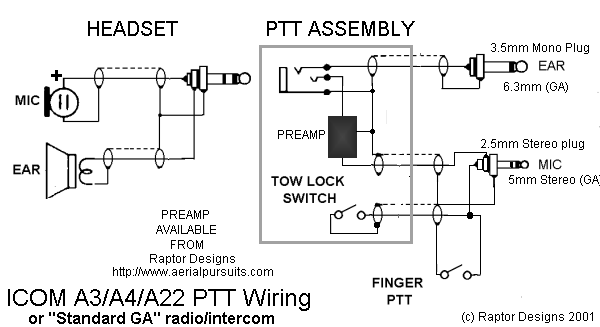
Note: This is
also the circuit for the Icom A6/A24, but these two radios may exhibit squealing
problems due to a design flaw that feeds back RF into their
microphone and power inputs. Icom know about the problem and only warrant
operation for a limited number of late model David Clark
headsets.
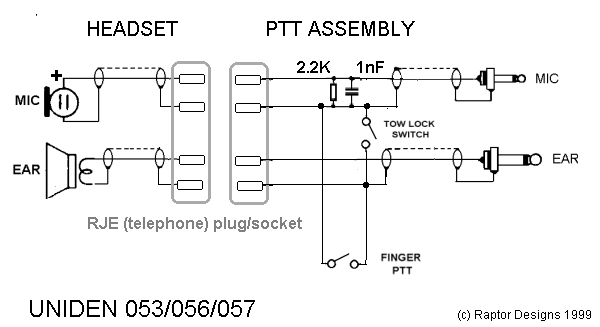
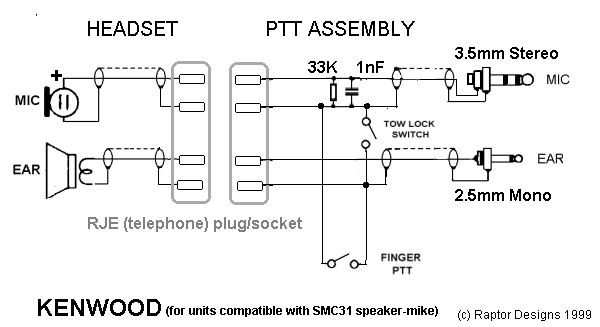
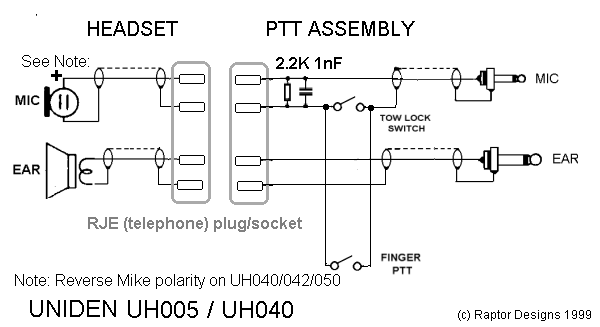
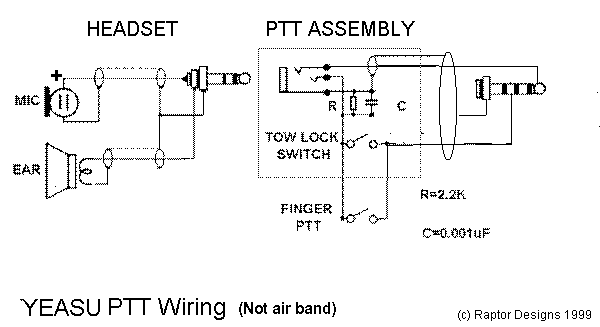
r